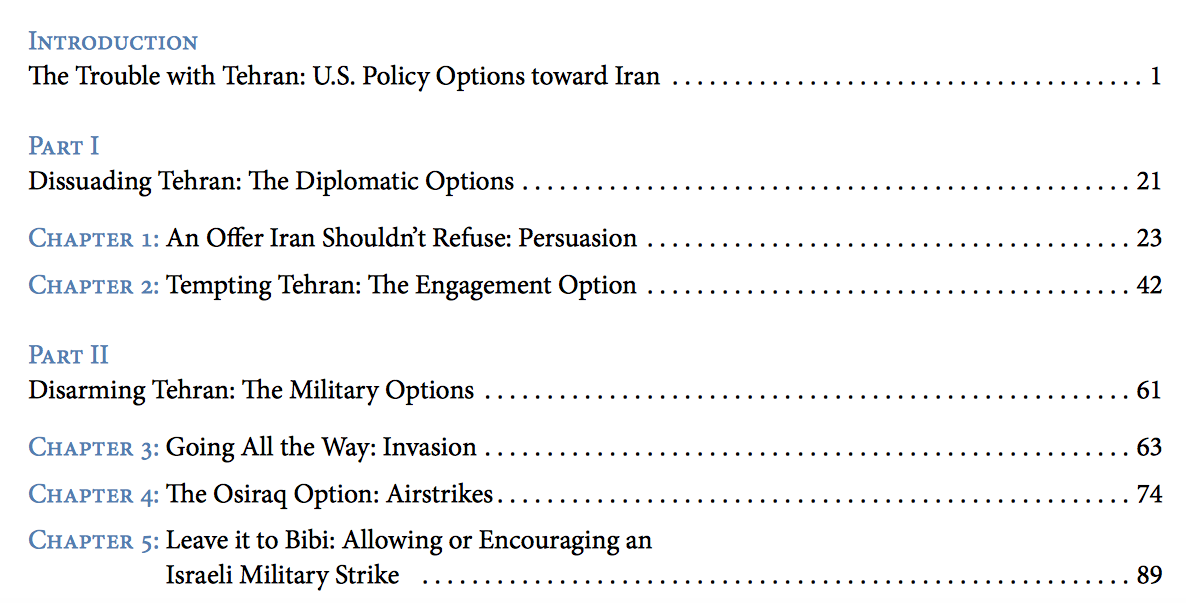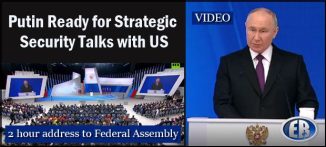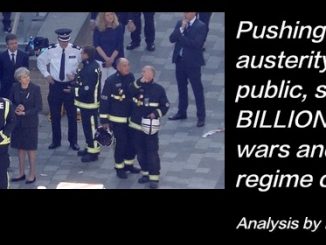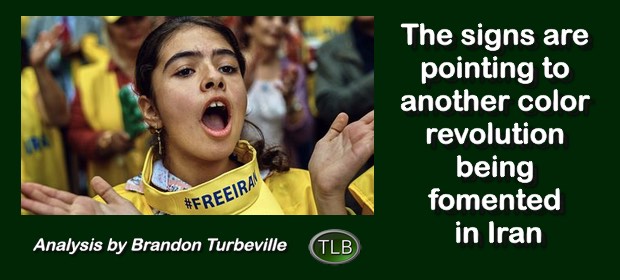
What Is Happening in Iran? Is Another “Color Revolution” Underway?
BRANDON TURBEVILLE
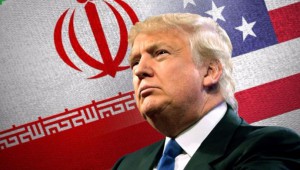
A familiar sight is taking place across Iran tonight and it has been for the last three days. Protests are taking place in numerous cities citing grievances and demanding that the Ayatollah and Iranian President step down. For a few days, the protests remained non-violent but now violence has indeed flared up as protesters have laid waste to a number of government properties and those belonging to “pro-government militias.”
Neo-cons in the American media and the U.S. President are all demanding that Americans stand with the “Iranian people” and the “protesters” in their “fight for freedom.”
The reason this sight is familiar is because we have seen it in Egypt, Libya, and Syria in the past as well as in Iran itself in the late 2000s. Protests that turn violent, a subsequent crackdown that either is violent or is reported as such, and the weight of American propaganda against the target government are all “Arab Spring” repeats that are themselves nothing more than the color revolution/destabilization apparatus that has been used by the West in countries all across the world for decades, particularly in the last twenty years.
What Do The Protesters Want?
The alleged demands of the protesters seem reasonable and legitimate enough. The Western media has, up until this point, been reporting that the main argument being made by the demonstrators center around economic concerns, i.e. falling living standards, unemployment, and rising food prices. However, as the third day of protests took place, the Western media began reporting that the protesters are demanding an end to religious dictatorship and policies of both the Ayatollah Khamenei and President Rouhani. According to some reports, female protesters have gone so far as to shout “death to Khamenei” and shed their hijabs in order to construct makeshift flags. Others say the protesters are focused on government corruption.
However, there is much question about these protests. The first question is “Are they organic Iranian protests?” This question has yet to be answered fully. Iran is most certainly a religious dictatorship and many Iranians want freedom from religious rule. However, it should be remembered that the United States and Israel have openly stated a desire to see Iranian influence broken and as recently as 2009, the United States attempted to engineer a color revolution in the country. The first three days of the Green Movement in Iran looked very much like the first three days of this current movement.
Clearly, economic concerns are a major issue in Iran, a country whose economy has been suffering for years under Western sanctions and its own inability to capitalize on a state-owned National Bank. Official unemployment in Iran is around 12% and it is likely that the real rate is much higher. Despite lifting of some sanctions, there is hardly economic growth in the country, another result of neo-liberal economic and trade policies. Yet, it is also worth noting that Khamenei has also been critical of the poor economy and the handling of economic issues by the government yet Khamenei is being insulted at the protests.
These demands are not unreasonable by any stretch of the imagination. However, the religious protests come at a very odd time. Iran recently liberalized its laws regarding women’s forced head coverings, so why protest now over religious laws?
In addition, special attention must be paid to the concept of “government corruption,” a hallmark of color revolutions since government corruption is often more of a conceptual issue than anything concrete. A step down from power from a few key people, wrist slaps, and token reform can all achieve an “end” to corruption while more concrete demands need concrete applications and thus present a minor loss to those who will be taking over the rains of power after the demonstrations have ceased.
There are also more concerning demands that can be found in the slogans being chanted by the demonstrators. First, in case it could be missed, the demonstrators are calling for the Ayatollah and the President to step down. In other words, they are calling for regime change. This is precisely what the United States, GCC, NATO, and Israel also want to see happen.
Second, numerous demonstrators are chanting “Let go of Palestine,” and “Not for Gaza, Not for Lebanon, I’d give my life (only) for Iran.” Again, protesters are now chanting foreign policy demands identical to that desired by the United States, NATO, GCC, and Israel. All this in a protest that is supposed to be about economic concerns.
Moon of Alabama, in its article entitled “Iran – Regime Change Agents Hijack Economic Protests,” reveals a number of important reports regarding the beginning of the protests and where they stand currently. MOA writes,
Protests against the (neo-)liberal economic policies of the Rohani government in Iran are justified. Official unemployment in Iran is above 12% and there is hardly any economic growth. The people in the streets are not the only ones who are dissatisfied with this:
Iran’s Supreme Leader Ayatollah Ali Khamenei, who has repeatedly criticized the government’s economic record, said on Wednesday that the nation was struggling with “high prices, inflation and recession”, and asked officials to resolve the problems with determination.
On Thursday and today the slogans of some protesters turned the call for economic relief into a call for regime change.
. . . . .
Today, Friday and the weekly day off in Iran, several more protest took place in other cities. A Reuters report from today:
About 300 demonstrators gathered in Kermanshah after what Fars called a “call by the anti-revolution” and shouted “Political prisoners should be freed” and “Freedom or death”, while destroying some public property. Fars did not name any opposition groups.
…
Footage, which could not be verified, showed protests in other cities including Sari and Rasht in the north, Qom south of Tehran, and Hamadan in the west.
Mohsen Nasj Hamadani, deputy security chief in Tehran province, said about 50 people had rallied in a Tehran square and most left after being asked by police, but a few who refused were “temporarily detained”, the ILNA news agency reported.
Some of these protests have genuine economic reasons but get hijacked by other interests:
In the central city of Isfahan, a resident said protesters joined a rally held by factory workers demanding back wages.
“The slogans quickly changed from the economy to those against (President Hassan) Rouhani and the Supreme Leader (Ayatollah Ali Khamenei),” the resident said by telephone.
…
Purely political protests are rare in Iran […] but demonstrations are often held by workers over layoffs or non-payment of salaries and people who hold deposits in non-regulated, bankrupt financial institutions.
…
Alamolhoda, the representative of Ayatollah Khamenei in northeastern Mashhad, said a few people had taken advantage of Thursday’s protests against rising prices to chant slogans against Iran’s role in regional conflicts.
…
“Some people had came to express their demands, but suddenly, in a crowd of hundreds, a small group that did not exceed 50 shouted deviant and horrendous slogans such as ‘Let go of Palestine’, ‘Not Gaza, not Lebanon, I’d give my life (only) for Iran’,” Alamolhoda said.
Media and Neo-Con Support
While it is to be expected from a virulently anti-Iran administration and mainstream press in the United States, it is interesting how the U.S. President immediately has latched onto the protests, encouraging Americans to stand with the protesters and their demands. This is coming from a man who rarely sees a protest that isn’t directed at him. Meanwhile, Neo-Con organs like FOX News are also repeating calls for Americans to support the brave “freedom fighters” in Iran. It is seldom, if ever, true that evil does good in the world so when Neo-Cons call for support for protests, eyebrows should be raised in skepticism.
It is also important to question just how popular these protests are. While mainstream western media and various terrorist organizations also conveniently supporting them paint them as involving tens of thousands at each demonstration, video and pictures tend to show only dozens to hundreds at the most while others wander about around them.
“A video of that protest in Mashad showed some 50 people chanting slogans with more bystanders just milling around,” writes MOA. . . . . “Two videos posted by BBC Persian and others I have seen show only small active protest groups with a dozen or so people while many more are just standing by or film the people who are chanting slogans.”
Trump Administration/Israel Agreement
The protests taking place in Iran are taking place only a month after the White House and Tel Aviv met to discuss a strategy on Iran.
“A delegation led by Israel’s National Security Adviser met with senior American officials in the White House earlier this month for a joint discussion on strategy to counter Iran’s aggression in the Middle East, a senior U.S. official confirmed to Haaretz,” wrote Haaretz agency. (Israeli Delegation Met U.S. Officials to Discuss ‘Iran Strategy,’ Syria)
AXIOS provides a quote from the meeting:
[T]he U.S. and Israel see eye to eye the different developments in the region and especially those that are connected to Iran. We reached an understandings regarding the strategy and the policy needed to counter Iran. Our understandings deal with the overall strategy but also with concrete goals, way of action and the means which need to be used to obtain those goals.
Could this apparent color revolution be the result of that US/Israeli meeting?
Color Revolution In Iran
The idea that a color revolution could be attempted in Iran is no fantasy. It would be a repeat of history. Remember, in 2009, an attempt at a color revolution deemed the “Green Revolution” was launched but was quickly put down by the iron fist of the Iranian government.
The Path To Persia
The plan for a Western or a Western/Israeli attack on Iran, along with the theatre of alleged US-Israeli tensions leading up to a strike and outright war, has been in the works for some time. For instance, in 2009, the Brookings Institution, a major banking, corporate, and military-industrial firm, released a report entitled “Which Path To Persia? Options For A New American Strategy For Iran,” in which the authors mapped out a plan which leaves no doubt as to the ultimate desire from the Western financier, corporate, and governing classes.
Screenshot from Brookings report: “Which Path To Persia? Options For A New American Strategy For Iran,”
The plan involves the description of a number of ways the Western oligarchy would be able to destroy Iran, including outright military invasion and occupation (see table of contents above). However, the report attempts to outline a number of methods that might possibly be implemented before direct military invasion would be necessary. The plan included attempting to foment destabilization inside Iran via the color revolution apparatus, violent unrest, proxy terrorism, and “limited airstrikes” conducted by the US, Israel or both.
The report states (emphasis added – ER),
Because the Iranian regime is widely disliked by many Iranians, the most obvious and palatable method of bringing about its demise would be to help foster a popular revolution along the lines of the “velvet revolutions” that toppled many communist governments in Eastern Europe beginning in 1989. For many proponents of regime change, it seems self-evident that the United States should encourage the Iranian people to take power in their own name, and that this would be the most legitimate method of regime change. After all, what Iranian or foreigner could object to helping the Iranian people fulfill their own desires?
Moreover, Iran’s own history would seem to suggest that such an event is plausible. During the 1906 Constitutional Movement, during the late 1930s, arguably during the 1950s, and again during the 1978 Iranian Revolution, coalitions of intellectuals, students, peasants, bazaari merchants, Marxists, constitutionalists, and clerics mobilized against an unpopular regime. In both 1906 and 1978, the revolutionaries secured the support of much of the populace and, in so doing, prevailed. There is evidence that the Islamic regime has antagonized many (perhaps all) of these same factions to the point where they again might be willing to support a change if they feel that it could succeed. This is the foundational belief of those Americans who support regime change, and their hope is that the United States can provide whatever the Iranian people need to believe that another revolution is feasible.
Of course, popular revolutions are incredibly complex and rare events. There is little scholarly consensus on what causes a popular revolution, or even the conditions that facilitate them. Even factors often associated with revolutions, such as military defeat, neglect of the military, economic crises, and splits within the elite have all been regular events across the world and throughout history, but only a very few have resulted in a popular revolution. Consequently, all of the literature on how best to promote a popular revolution— in Iran or anywhere else—is highly speculative. Nevertheless, it is the one policy option that holds out the prospect that the United States might eliminate all of the problems it faces from Iran, do so at a bearable cost, and do so in a manner that is acceptable to the Iranian people and most of the rest of the world.
Conclusion
While the situation in Iran continues to develop, it appears that another color revolution is underway. While many of the demands are legitimate, all signs are pointing toward Western treachery in an attempt to break Iran in the final domino to fall in the Middle East before an even bigger confrontation is ignited. Destroying Iran would also destroy Hezbollah, weaken Syria and Russia, and threaten Israel. Whether or not it will succeed will depend on the level of subversion that has been possible by the United States intelligence apparatus since 2009 and the ability of Iran to squash the revolt. If anything can be learned from the 2009 revolution, Iran will move quickly and will smash the protests with an iron fist. However, if the protests taking place in Iran today are indeed a color revolution and if the West is committed, the Path to Persia will likely see an escalation in activity, violence, and ultimately directly military confrontation by proxy and even by the U.S. military itself.
We will be following these protests in detail over the coming days.
************
Original article
ER recommends other articles by Global Research, and Activist Post where this article originally appeared
Brandon Turbeville writes for Activist Post – article archive here – He is the author of seven books, Codex Alimentarius — The End of Health Freedom, 7 Real Conspiracies, Five Sense Solutions and Dispatches From a Dissident, volume 1 and volume 2, The Road to Damascus: The Anglo-American Assault on Syria, The Difference it Makes: 36 Reasons Why Hillary Clinton Should Never Be President, and Resisting The Empire: The Plan To Destroy Syria And How The Future Of The World Depends On The Outcome. Turbeville has published over 1000 articles on a wide variety of subjects including health, economics, government corruption, and civil liberties. Brandon Turbeville’s radio show Truth on The Tracks can be found every Monday night 9 pm EST at UCYTV. His website is BrandonTurbeville.com He is available for radio and TV interviews. Please contact activistpost (at) gmail.com.
Featured image courtesy of Andres Kudacki / AP


